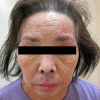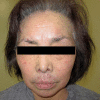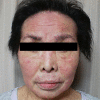Need for Flexible Adjustment of the Treatment Schedule for Aprepitant Administration against Erlotinib-Induced Refractory Pruritus and Skin Rush
- PMID: 30792647
- PMCID: PMC6381921
- DOI: 10.1159/000493256
Need for Flexible Adjustment of the Treatment Schedule for Aprepitant Administration against Erlotinib-Induced Refractory Pruritus and Skin Rush
Abstract
Common dermatological side-effects associated with erlotinib, epidermal growth factor receptor (EGFR) tyrosine kinase inhibitor (TKI), include pruritus and skin rash, which are mediated by substance P, leading to the occasional discontinuation of cancer treatment. Aprepitant is an antagonist of neurokinin-1 receptor, through which substance P activates the pruritogens. Thus, aprepitant is expected to offer a promising option for the treatment of erlotinib-induced pruritus. However, the appropriate treatment schedule for aprepitant administration is under consideration. Here, we discuss the need for flexible adjustment of the treatment schedule for aprepitant administration against erlotinib-induced refractory pruritus and skin rush. A 71-year-old female smoker presented with stage IV EGFR-mutated lung adenocarcinoma. She was started on erlotinib at 150 mg/day. However, by 28 days, severe pruritus and acneiform skin rush resistant to standard therapies occurred, resulting in the interruption of erlotinib therapy. After recovery, she was restarted on erlotinib at 100 mg/day. However, severe pruritus and skin rush developed again within 2 weeks. Then, we started the first 3-day dose of aprepitant (125 mg on day 1, 80 mg on day 3, and 80 mg on day 5) based on the results of the previous prospective study, which showed the success rate of 100% with at least the second dose of aprepitant. However, the pruritus and skin rush exacerbated again within 4 weeks. Therefore, we started the second 3-day dose of aprepitant, but in vain. At this point, as the patient-centered medicine, bi-weekly schedule of the 3-day dose of aprepitant was considered and, then, adopted. As the results, the pruritus and skin rush remained well-controlled throughout the subsequent treatment with erlotinib.
Keywords: Aprepitant; Erlotinib; Lung cancer; Pruritus; Skin rush.
Figures




Similar articles
-
Substance P receptor blocker, aprepitant, inhibited cutaneous and other neurogenic inflammation side effects of the EGFR1-TKI, erlotinib.Mol Cell Biochem. 2020 Feb;465(1-2):175-185. doi: 10.1007/s11010-019-03677-7. Epub 2019 Dec 18. Mol Cell Biochem. 2020. PMID: 31853800
-
Aprepitant for management of severe pruritus related to biological cancer treatments: a pilot study.Lancet Oncol. 2012 Oct;13(10):1020-4. doi: 10.1016/S1470-2045(12)70373-X. Epub 2012 Sep 18. Lancet Oncol. 2012. PMID: 22995650 Clinical Trial.
-
Paraneoplastic pruritus presenting with Hodgkin's lymphoma: a case report.J Med Case Rep. 2014 Sep 8;8:300. doi: 10.1186/1752-1947-8-300. J Med Case Rep. 2014. PMID: 25200537 Free PMC article.
-
Erlotinib-related skin toxicities: treatment strategies in patients with metastatic non-small cell lung cancer.J Am Acad Dermatol. 2013 Sep;69(3):463-72. doi: 10.1016/j.jaad.2013.02.025. Epub 2013 Apr 17. J Am Acad Dermatol. 2013. PMID: 23602600 Review.
-
Aprepitant for the Treatment of Chronic Refractory Pruritus.Biomed Res Int. 2017;2017:4790810. doi: 10.1155/2017/4790810. Epub 2017 Sep 19. Biomed Res Int. 2017. PMID: 29057261 Free PMC article. Review.
Cited by
-
Neurokinin-1 antagonist orvepitant for EGFRI-induced pruritus in patients with cancer: a randomised, placebo-controlled phase II trial.BMJ Open. 2020 Feb 6;10(2):e030114. doi: 10.1136/bmjopen-2019-030114. BMJ Open. 2020. PMID: 32034016 Free PMC article. Clinical Trial.
References
-
- Lynch TJ, Jr, Kim ES, Eaby B, Garey J, West DP, Lacouture ME. Epidermal growth factor receptor inhibitor-associated cutaneous toxicities: an evolving paradigm in clinical management. Oncologist. 2007 May;12((5)):610–21. - PubMed
-
- Gerber PA, Buhren BA, Homey B. More on aprepitant for erlotinib-induced pruritus. N Engl J Med. 2011 Feb;364((5)):486–7. - PubMed
-
- Vincenzi B, Tonini G, Santini D. Aprepitant for erlotinib-induced pruritus. N Engl J Med. 2010 Jul;363((4)):397–8. - PubMed
-
- Mir O, Blanchet B, Goldwasser F. More on aprepitant for erlotinib-induced pruritus. N Engl J Med. 2011 Feb;364((5)):487. - PubMed
Publication types
LinkOut - more resources
Full Text Sources
Research Materials
Miscellaneous

